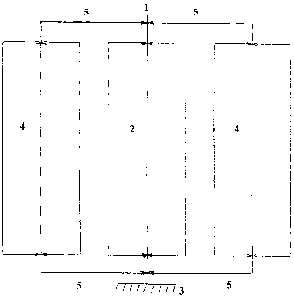Note : Les descriptions sont présentées dans la langue officielle dans laquelle elles ont été soumises.
CA 02715952 2010-09-29
ROTOR PLATFORM OF AERODYNAMIC FORCE AND METHOD OF
AERODYNAMIC FORCE GENERATION
Description of the invention
A rotor platform of aerodynamic force and a method of aerodynamic force
generation
relate to wind power engineering and are meant for generating lift and
transverse
aerodynamic forces.
It is known that aerodynamic force results from the interaction of physical
objects with
the ambient air flow (1, page 484).
An airplane wing is one of the simplest well-known physical objects generating
in the
ambient air flow an aerodynamic force in the form of a lift force (2, page
505).
A wing lift force is produced owing to its unsymmetrical form, with the air
flow
streaming around it to pass its curved upper surface at the velocity larger
than the velocity of the
air flow passing its flat bottom. Due to the difference in the velocities, as
per Bernoulli equation,
a lift force is produced, which value is derived via Kutta-Joukowski theorem
as given below:
*r~
1' pVrL = C. (3, crp. 141-142)
T - velocity circulation value;
p - air density;
V- windstream velocity;
S - wing surface square in plain view;
L - wing length;
C,, - dimensionless coefficient dependant on the physical properties of air,
the wing itself and
the wing orientation against the air flow.
A lift force Y in symbolic expression as cited above, or as follows
A = pTVL,
as per (4, page 121) is also termed transverse and its value is proportional
to the flow velocity
squared and the value of coefficient Cy C.
"The value Cy bears considerable importance as the larger it is the lesser are
the take-off
speed and landing speed of an airplane", i.e. the minimum air flow velocity
generating the
CA 02715952 2010-09-29
2
specified lift force depends directly on the value Cy. In a particularly
preferred embodiment of the
wing, the value Cy does not exceed the values 1, 2 (3, pages 141-142).
It is known that the cylinder rotating around the longitudinal axis "...under
equal
conditions creates a force 10 times larger that the wing does" (5, pages 55-
57), i.e. the
coefficient Cy gains the value n-order larger than that of the airplane wing.
The proposed invention is aimed at utilizing the potential of generating
aerodynamic
force by the cylindrical body rotating in air flow and creating hereon a
simple and efficient
technical device capable of generating powerful lift and transverse force
suitable for practical
implementation.
The schematic representation of the rotor platform of aerodynamic force is
presented in
Fig. 1. The basis of the construction is the rotor unit of identical
symmetrical coplanar central
and lateral rotors with load-bearing elements of logarithmic spiral profile,
the prototype thereof
being a marine rotary wind-powered propulsion - BY Ns 8234.
The rotation longitudinal axis 1 of the central rotor 2 is fixed in the
platform frame 3,
whereas the longitudinal axes of the lateral rotors 4 are rigidly tied by
cross-members 5, with
the centers of the cross-members via the bearing units coupled with the fixed
rotation axis of the
central rotor, which allows the firmly inter-tied lateral rotors to repeatedly
take a symmetrical
position in a single plane as per the central rotor.
It is also known that air flow flowing around the rotating body causes
circulation of the air
flow around its contour, the velocity thereof is summed up with the velocity
of the flow when
they are co-directional (4, pages 100-105), which imparts additional kinetic
energy to the flow.
The essence of the invention consists in using the flow with additional
velocity to act on
the consecutive rotor.
The method of generating aerodynamic force by the rotor platform, aerodynamic
force
being a sum of aerodynamic forces generated by each platform rotor, is shown
in Fig. 2.
The air flow with initial velocity Vi falls on the first rotor and sets it to
rotation at the
velocity V1R. Summation of the rotation velocity and flow velocity results in
the flow velocity
that substantially exceeds its initial value
V1S = V1 + V1R.
The flow further falls on the consecutive rotor at the velocity V1S, sets it
to rotation at the
velocity V2R, summation of velocities results in the velocity V2S that renders
its effect on the
consequent rotor, whereby fully repeating the previous cycle.
CA 02715952 2010-09-29
3
Thus, the value of aerodynamic force generated by the rotor platform according
to Kutta-
Joukowski theorem is expressed as follows:
Y=CvP(Vr2 +Vis2 +V2s2)S,
2 2
References:
1. The Great Soviet Encyclopedia, 3rd edition., vol. 2.
2. The Great Soviet Encyclopedia, 3d edition., vol. 13.
3. The Great Soviet Encyclopedia, 3rd edition., vol. 20.
4. Prandtle L., Fluid Mechanics. M., 1951.
5. Merkoulov V.I. Hydrostatics, Known and Unknown, M.,1989
6. Patent BY No. 8234.
